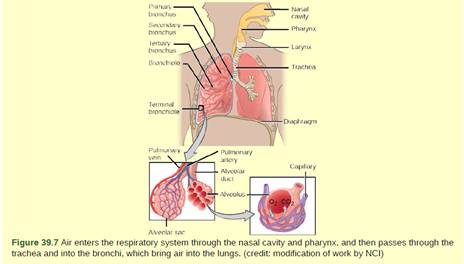
Figure 39.7 Which of the following statements about the mammalian respiratory system is false?
- When we breathe in, air travels from the pharynx to the trachea.

Introduction:
In the respiratory system, the air enters into the body through nostrils to nose. This nostril has two nasal cavities with hair and mucus. In this cavity, airs is filtered and maintain its temperature according to body temperature. Next air passes through pharynx, and removed germs here and further air moves to larynx then trachea. In trachea again air is filtered by mucus. Finally two bronchi made of extent form of trachea and further air pass by each of one leads to lung.
Answer to Problem 1VCQ
Correct answer:
Correct answer is option (b) the bronchioles branch in to bronchi.
Explanation of Solution
Explanation/justification for the correct answer:
Option (c) is given as the bronchioles branch in to bronchi. Air pass from the cavity of the nasal passes using throat that known as the pharynx, further move to the voice box, which known as the larynx. Further air flows in order to reach the trachea and eventually air pass to bronchi and bronchioles that are present in lungs.
Explanation for incorrect answer:
Option (a) is given as when we breathe in, air travels from the pharynx to trachea, When we breath in, air travels from the pharynx to trachea, is a true statement. Hence, it is an incorrect answer.
Option (c) is given as alveolar ducts connect to alveolar sacs. Alveolar ducts connect to alveolar sacs is a true statement. Hence, it is an incorrect answer.
Option (d) is given as gas exchange between the lung and blood takes place in the alveolus. Gas exchange between the lung and blood takes place in the alveolus, is a true statement. Hence, it is an incorrect answer.
Thus, for mammalian respiratory system bronchioles branch in to bronchi is not true statement.
Want to see more full solutions like this?
Chapter 39 Solutions
Biology 2e
Additional Science Textbook Solutions
Genetic Analysis: An Integrated Approach (3rd Edition)
Microbiology: An Introduction
Biology: Life on Earth (11th Edition)
Human Anatomy & Physiology (2nd Edition)
Applications and Investigations in Earth Science (9th Edition)
Microbiology with Diseases by Body System (5th Edition)
- What is behavioral adaptarrow_forward22. Which of the following mutant proteins is expected to have a dominant negative effect when over- expressed in normal cells? a. mutant PI3-kinase that lacks the SH2 domain but retains the kinase function b. mutant Grb2 protein that cannot bind to RTK c. mutant RTK that lacks the extracellular domain d. mutant PDK that has the PH domain but lost the kinase function e. all of the abovearrow_forwardWhat is the label ?arrow_forward
- Can you described the image? Can you explain the question as well their answer and how to get to an answer to an problem like this?arrow_forwardglg 112 mid unit assignment Identifying melting processesarrow_forwardGive only the mode of inheritance consistent with all three pedigrees and only two reasons that support this, nothing more, (it shouldn't take too long)arrow_forward
- Oarrow_forwardDescribe the principle of homeostasis.arrow_forwardExplain how the hormones of the glands listed below travel around the body to target organs and tissues : Pituitary gland Hypothalamus Thyroid Parathyroid Adrenal Pineal Pancreas(islets of langerhans) Gonads (testes and ovaries) Placentaarrow_forward
 Biology 2eBiologyISBN:9781947172517Author:Matthew Douglas, Jung Choi, Mary Ann ClarkPublisher:OpenStax
Biology 2eBiologyISBN:9781947172517Author:Matthew Douglas, Jung Choi, Mary Ann ClarkPublisher:OpenStax Concepts of BiologyBiologyISBN:9781938168116Author:Samantha Fowler, Rebecca Roush, James WisePublisher:OpenStax College
Concepts of BiologyBiologyISBN:9781938168116Author:Samantha Fowler, Rebecca Roush, James WisePublisher:OpenStax College Biology (MindTap Course List)BiologyISBN:9781337392938Author:Eldra Solomon, Charles Martin, Diana W. Martin, Linda R. BergPublisher:Cengage Learning
Biology (MindTap Course List)BiologyISBN:9781337392938Author:Eldra Solomon, Charles Martin, Diana W. Martin, Linda R. BergPublisher:Cengage Learning
 Biology: The Dynamic Science (MindTap Course List)BiologyISBN:9781305389892Author:Peter J. Russell, Paul E. Hertz, Beverly McMillanPublisher:Cengage Learning
Biology: The Dynamic Science (MindTap Course List)BiologyISBN:9781305389892Author:Peter J. Russell, Paul E. Hertz, Beverly McMillanPublisher:Cengage Learning





